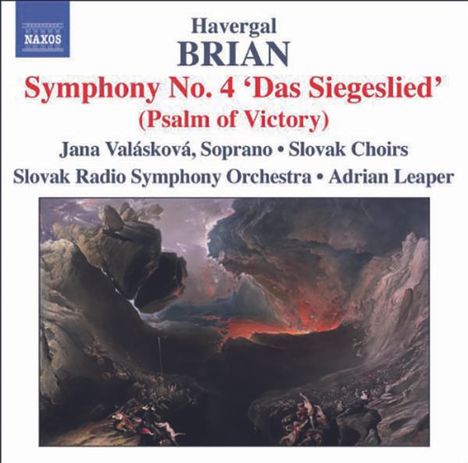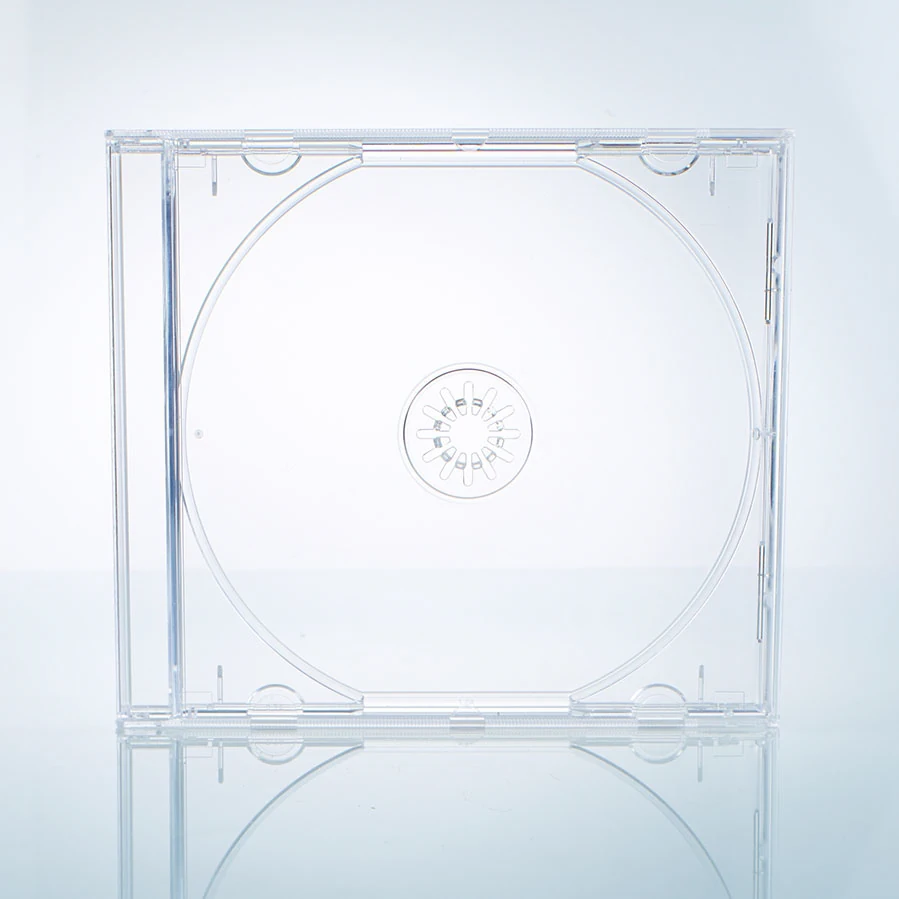Havergal Brian: Symphonien Nr.4 & 12 auf CD
Symphonien Nr.4 & 12
Herkömmliche CD, die mit allen CD-Playern und Computerlaufwerken, aber auch mit den meisten SACD- oder Multiplayern abspielbar ist.
Lassen Sie sich über unseren eCourier benachrichtigen, falls das Produkt bestellt werden kann.
- Künstler:
- Valaskova, Cantus Choir, RSO Bratislava, Leaper
- Label:
- Naxos
- Aufnahmejahr ca.:
- 1991
- UPC/EAN:
- 0747313030873
- Erscheinungstermin:
- 4.12.2006
A lifelong admirer of German musical culture, literature and thought, Brian wrote his Fourth Symphony "Das Siegeslied" (Psalm of Victory) at a time when Germany's cultural heritage was being distorted by nationalism. Scored for double chorus, soprano and an orchestra of massive proportions, the work comprises two wild, martial movements enclosing a slow and contemplative one. With its peculiarly pitiless text glorifying "Macht und Kraft" (might and power) and music of barbaric splendour and violent expressive contrast, the Symphony can be seen as Brian's apocalyptic vision of the direction in which Germany was heading. For the single-movement Twelfth Symphony, Brian still employs a large orchestra, but the language is pared down to essentials.
Havergal Brian (1876-1972) was not a religious man in any conventional sense, but he was deeply stirred by the poetry of certain texts from the Judaeo-Christian traditions, which seemed to him to express archetypal truths about the human condition. Thus, for instance, the Te Deum, which he set as Part 2 of his First Symphony, The Gothic (recorded on Naxos 8.557418-19), and thus, too, certain of the Psalms of David.
A favourite was Psalm 68, "Let God arise, let his enemies be scattered". This had also been a favourite with Oliver Cromwell, who ordered his troops to sing it before the Battle of Dunbar in the English Civil War. Cromwell, the great Puritan soldier, was one of Brian's early heroes, which may account for his own fondness for the Psalm. As early as 1907, Brian essayed a choral-orchestral setting of it under the title Let God Arise, but nothing of that work has survived (if indeed it was more than sketched). However, in 1932-33 he returned to the Psalm text, this time in the German version of Martin Luther ("Es stehe Gott auf"), and made it the basis of his monumental Fourth Symphony for double chorus, soprano solo, and very large orchestra – Brian's only choral symphony apart from The Gothic. He gave it the German title Das Siegeslied: The Psalm of Victory.
This Psalm is no simple paean of praise. The text exults at the thought of the violent doom which awaits the unrighteous, and at the chosen of the Lord dipping their feet in their enemies' blood. It is a sacred song of war, as Brian's music makes only too graphically explicit. Why did he compose Das Siegeslied when he did, and why did he set the Psalm-text in German?
One reason, clearly, must be that the Fourth Symphony belongs to the brief period when Brian's music had unexpectedly been taken up by the Hamburg-based publishers Cranz & Co. 1932 was the year that Cranz published the full score of The Gothic, and interested Fritz Busch to the extent of planning a production of Brian's opera The Tigers in Dresden. Brian would certainly have had hopes of securing further performances of his works in Germany, and he presumably believed that a setting of a German text would be of considerable advantage in that process. However it also seems likely that he felt he had something to say to Germany, at a fateful juncture in that nation's history.
Brian was not only a lifelong admirer of the German musical culture exemplified by Schütz, Bach, Handel, Beethoven, Wagner, and Strauss, but also of German literature and thought: above all the works of Goethe, whose Faust was a prime inspiration behind The Gothic. (Much later, in 1955-6, Brian was to turn Goethe's drama into an opera, in German.) Considering that he owed an immense amount to German art, Brian subscribed to German newspapers to keep abreast of German cultural events. He was thus intensely aware of the rise of Nazism, and of its coarse nationalistic distortion of Germany's creative heritage. Hitler's assumption of power, the burning of the Reichstag, and the Führer's order to "break the Jewish stranglehold on Western music" all occurred while Brian was composing Das Siegeslied. The grim, barbaric splendour and mail-clad violence of his Symphony, with its peculiarly pitiless text glorifying "Macht und Kraft" (might and power), strongly suggests that he saw, in apocalyptic terms, the direction in which the German Volk was being herded. In some respects Brian's idiom in Das Siegeslied establishes an unexpected kinship of expression with Alexander von Zemlinsky's near-contemporary (in fact, slightly later) setting of Psalm 13; but Brian's is much the vaster and more complex undertaking. His music unleashes the darkest of Old Testament passions, disturbingly conjoined with Lutheran German, and what Thomas Mann called the "blood-boltered barbarism" of the modern totalitarian state. Against this, in humane contrast, Brian places episodes of simple piety, pastoral serenity, and (in the slow movement) an almost metaphysical vision of peace and war in Heaven. But the baleful sounds of a nation on the march (or at a political rally) eventually overwhelm all else.
Brian's Fourth Symphony seems, therefore, to create a multiple perspective between three levels of meaning. First and overtly it is a formal celebratory setting of a victory psalm, an equivalent (in full twentieth-century manner) to Handel's Dettingen Te Deum or Brahms' Triumphlied. But, second, the music is of such wildness, of such violent expressive contrast, disruptive chromaticism and dissonance, that it predicates the apocalyptic denunciation of state militarism which I have outlined above. And third, it is furthermore an invocation, a Cromwellian call to fight the good fight: the enemies who must be scattered are precisely those dark forces whose goose-stepping marches the music evokes so vividly.
To realise this complex vision, Brian - in addition to his vocal forces of large double chorus and soprano - deploys an orchestra of massive dimensions, including many of the unusual woodwind that had featured in The Gothic (alto flute, two oboi d'amore, bass oboe, bassett-horns, pedal clarinet, etc.), with a large contingent of brass and percussion and an extensive rôle for the organ. He also approaches symphonic form in his most fluid and flexible manner. Das Siegeslied, cast in three movements which play without a break, might almost be considered a huge ternary form, two brazen and martial movements enclosing a slow and contemplative one. The first two of these movements are themselves quite clearly tripartite in design, their central sections distinguished from the outer ones by tempo, texture, dynamics, and musical character. Though less easy to discern, the finale too falls into a broad three-part form. Each of the movements has themes proper to itself, though there are also Leitmotivic entities which recur from movement to movement; and the return of the Symphony's initial march-rhythm in its final bars closes a vast circle of continuous, allusive development and metamorphosis.
The Symphony begins Maestoso [Track 1] in a blaze of pomp and splendour: a thunderous C major march in neo-Baroque style, reminiscent of some Handelian coronation anthem. But with the very first entry of the choruses, in tortuous chromatic polyphony [2], this ideal of simple rejoicing is completely overturned. Throughout the first portion of the movement moods of awe, urgency and violence alternate with brief, varied reminiscences of the optimistic opening march, eventually building to a ferocious climax. There follows a central Lento section [3] for the choirs alone, "Du gabst, Gott, einen gnädigen Regen" (Thou, O God, did send a plentiful rain), beginning in simple serenity but becoming steadily more chromaticized and Angst-ridden. The final part of the movement then strikes in, [4] Allegro vivo ma deciso, "Der Herr gab das Wort" (The Lord gave the word), painting in sound a scene which seems to be of pursuit and carnage after a great battle. The most violent and rhythmically compulsive music so far, it sweeps along in fury only to reach a drastically abrupt conclusion as the voices hail the division of the spoils.
The Lento slow movement for soprano and orchestra, which follows with only a brief pause, is one of Brian's most imaginative inspirations. For much of its length it has a weird voluptuousness unparalleled in his work. It begins innocently enough [5] with calm pastoral music in D major and a haunting violin solo in the manner of a passionate vocalise. The soprano enters with "Wenn ihr zwischen den Hürden laget" (Though you have lain among the pots, yet shall ye be as the wings of a dove covered in silver). This develops into a duet with the violin, ramifying through some of Brian's most glittering textures with prominent glockenspiel, celesta, and harps. A feeling of ecstatic yet mysterious lyricism pervades the fabric of the music. However, the mood changes abruptly [6] with the approach of "Der Wagen Gottes" (The Chariots of God) - the words inspire an obsessive, pounding Allegro vivace, apparently an echo of wars in Heaven. Brian drives this to a monumental climax, with a cavernous descent into the depths of the brass, as if rebel angels have been hurled into the abyss. The soprano returns [7], radiant, untroubled, for "Du bist in die Höhe gefahren" (Thou hast ascended on high), in music of chill beauty founded on a chaconne-like ground bass; this leads to a solemn coda of echoing brass.
The finale (Bewegt) is the longest and most episodic of the movements. Its mysterious, Brucknerian beginnings [8] "Gelobet sei der Herr" (Blessed be the Lord), soon mushroom into a huge victory-parade in sound, lumbering march-rhythms giving way to a grand broad tune [9] for "Der Herr hat gesagt" (The Lord said). Sardonically contrasting, scherzo-like music [10] ensues for "dass dein Fuß" (that thy foot may be dipped in the blood of thine enemies), treating a short and bloodthirsty text to bizarrely extended development. Two further sections of parade-ground manoeuvres take over [11] for "Man sieht, Gott" (They have seen thy goings, O God) and then [12] "Lobet Gott den Herrn" (Bless ye God in the congregations), where jubilation and naked force seem inextricably entwined. (The verse about "the girls playing timbrels" is set to some of the most pulverizing music of all!)
The mood changes with a majestic Solenne section [13] setting "Die Fürsten aus Ägypten" (Princes shall come out of Egypt), which is in fact an elaborately concealed and highly complex canonic invention on the great Lutheran chorale-tune "Ein' feste Burg". The melody becomes a further source of motivic development as the predominantly martial and march-like idiom of the earlier sections returns (though with very little actual repetition of material), and the concluding portion accumulates one triumphant, overbearing climax after another. "Ihr Königreiche auf Erden" (Sing unto God, ye Kingdoms of the Earth) is a jubilant Allegro moderato, succeeded by an Andante maestoso [14] for "Gebet Gott die Macht" (Ascribe ye strength unto God). As this latter section rises to a pinnacle of sonorous power, the rhythms of the march which began the entire Symphony burst in upon the proceedings, and Das Siegeslied ends with a gigantic, full-throated cadence of naked force: "Gelobt sei Gott!"
Though Brian's Fourth Symphony may, by intention, have been a warning for its times, it was destined to remain unplayed for 34 years, enshrouded in the neglect that overtook all Brian's works throughout the inter-war years. The world premiere did not take place until 1967, in a BBC broadcast with Honor Sheppard (soprano), the Halifax Choral Society, the Leeds Philharmonic Choir, and the BBC Northern Symphony Orchestra conducted by Maurice Handford. The work received its first public performance before a huge audience in London's Alexandra Palace in 1974, with Felicity Palmer as the soloist and the London Philharmonic Orchestra and Choruses conducted by John Poole.
Brian composed his Twelfth Symphony a quarter of a century after Das Siegeslied, in early 1957, and it is a very different proposition: purely instrumental, extremely concise (in fact, the shortest symphony he had yet written) and inspired by Greek Tragedy - another of the composer's abiding passions. He still employs a large orchestra (though not the gigantic forces of No. 4), but the language is pared down to essentials, the argument proceeding by abrupt juxtapositions of intensely dramatic music gestures.
Ancient drama is indeed at the heart of Symphony No. 12, an imaginative reflection of the moods of the Agamemnon of Aeschylus. Later in 1957 Brian went on to set the tragedy as a one-act opera, "a curtain-raiser to Strauss's Elektra"; and some years afterwards he suggested symphony and opera could be performed together, using the former as a prelude. No. 12 is indeed brief enough to fulfil that rôle - but the brevity is the product of extreme compression in argument, language, and structure. What Brian renounces in duration he gains in power of suggestion, in potent sonic imagery and freedom of form. Thematic development in the strict sense has little function here: the composer creates unity out of diversity by balancing similar types of texture and activity to establish allusive links between ideas, with a minimum of restatement.
Within the span of its single short movement, Symphony No. 12 suggests a vestigial four-movement design, framed by brief introduction and epilogue. The work opens [15] with ghostly fragments of sound - a glockenspiel solo, a timpani rhythm, mysterious stirrings in flutes and harp, and so on. Snatches of a funeral-march rhythm sound urgently in the strings before the first main section, a hard-bitten Allegro maestoso, gets under way [16]. This miniature "movement" is an energetic contrapuntal fantasy, featuring some of Brian's most abrasive orchestration and sweeping up a whole complex of disparate ideas to a grim climax. Before long, however, a shadow falls across the music (A Tempo Marcia Lento) and an inexorable funeral march [17] of the deepest tragic hue gets under way. This is the heart of the entire Symphony - a dark, obsessive procession in a compulsive slow - march rhythm, shot through by weird orchestral colours and rising at length to a peak of sombre grandeur. An intense and intimate slow movement [18], Adagio espressivo, follows, scored almost entirely for strings and bringing an assuaging sense of calm. Distant, almost subterranean horn-calls summon a strenuous, angular "finale" [19], Allegro vivo, by turns heroic and grotesque. Its tumultuous orchestral invention culminates in a dénouement of wrathful, tragic force. A brief coda, Adagio ma pesante, rings down the curtain on the fateful stroke of the gong.
Brian's Twelfth Symphony received its première in a BBC broadcast on 5 November 1959, with the London Symphony Orchestra conducted by Harry Newstone. The first public performance was given to mark the composer's 90th birthday year in a Promenade Concert at London's Royal Albert Hall on 4 August 1966; the BBC Symphony Orchestra was conducted by Norman Del Mar.
Malcolm MacDonald
Rezensionen
FonoForum 6/93: "Die vierte Sinfonie wartet mit fünf verschiedenen Haupt- und Nebenchören auf. Die Orchesterleistung ist - an den Ansprüchen gemessen die Brian hier stellt - sehr ordentlich."-
Tracklisting
-
Mitwirkende
Disk 1 von 1 (CD)
-
1 Symphony No. 4, "Das Siegeslied" (Psalm of Victory): I. Maestoso: Ein Psalmlied Davids
-
2 Symphony No. 4, "Das Siegeslied" (Psalm of Victory): I. Es stehe Gott auf
-
3 Symphony No. 4, "Das Siegeslied" (Psalm of Victory): I. Lento: Du gabst, Gott, einen gnadigen Regen
-
4 Symphony No. 4, "Das Siegeslied" (Psalm of Victory): I. Allegro vivo ma deciso: Der Herr gab das Wort
-
5 Symphony No. 4, "Das Siegeslied" (Psalm of Victory): II. Wenn ihr zwischen den Hurden laget
-
6 Symphony No. 4, "Das Siegeslied" (Psalm of Victory): II. Der Wagen Gottes sind vieltausendmal tausend
-
7 Symphony No. 4, "Das Siegeslied" (Psalm of Victory): II. Du bist in die Hohe gefahren
-
8 Symphony No. 4, "das Siegeslied" (Psalm Of Victory): Iii. Bewegt: Gelobet Sei Der Herr Taglich
-
9 Symphony No. 4, "das Siegeslied" (Psalm Of Victory): Iii. Der Herr Hat Gesagt
-
10 Symphony No. 4, "das Siegeslied" (Psalm Of Victory): Iii. Dass Dein Fuss In Der Feinde Blut Gefarbt Werde
-
11 Symphony No. 4, "das Siegeslied" (Psalm Of Victory): Iii. Man Sieht, Gott, Wie Du Einherziehst
-
12 Symphony No. 4, "das Siegeslied" (Psalm Of Victory): Iii. "lobet Gott Den Herrn In Den Versammlungen #"
-
13 Symphony No. 4, "das Siegeslied" (Psalm Of Victory): Iii. Solenne: Die Fursten Aus Agypten Werden Kommen
-
14 Symphony No. 4, "das Siegeslied" (Psalm Of Victory): Iii. Andante Maestoso: Gebet Gott Die Macht!
-
15 Symphony No. 12: Introduction -
-
16 Symphony No. 12: Allegro maestoso -
-
17 Symphony No. 12: A Tempo Marcia Lento -
-
18 Symphony No. 12: Adagio espressivo -
-
19 Symphony No. 12: Allegro vivo
Mehr von Havergal Brian
-
Havergal BrianSymphonie Nr.2CDAktueller Preis: EUR 14,99
-
Havergal BrianSymphonie Nr.13CDAktueller Preis: EUR 15,99
-
Havergal BrianSymphonie Nr.1 "The Gothic"2 CDsVorheriger Preis EUR 29,99, reduziert um 0%Aktueller Preis: EUR 22,99
-
Havergal BrianOrchesterwerke Vol.1CDAktueller Preis: EUR 15,99








